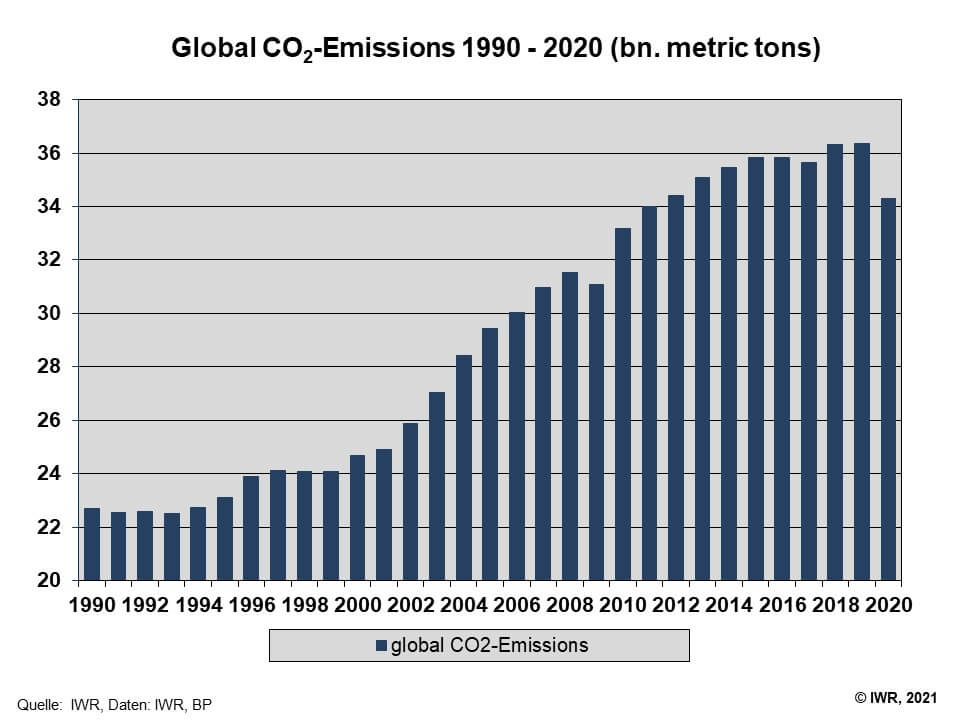Trend opinion
Climate protection requires a limitation of greenhouses gases. That cannot be done without a global agreement on climate protection, such as the Kyoto Protocol. This relies on countries imposing limits on themselves.
Facts
The fact is: In 2014, Global CO2 emissions - at 35.5 bln tonnes - again reached a new record level. Since 1990 the energy-related emissions have increased by more than 50 per cent. The results of the annual UN climate conferences and the surge in global CO2 emissions, is a clear indication of the world community´s inaction on this issue. The most recent negotiations anticipate the drafting of a global agreement in Paris in 2015, which would then take effect beginning in 2020. It seems to be the case that the issue of climate change is destined to be dragged out further into the future. It is time that a change in the current paradigm is considered and alternatives are developed.
1.Worldwide CO2 emissions in 2014 already over 50 percent up on 1990
Despite the Kyoto Protocol and annual negotiations on climate protection with almost 200 states participating, no lowering of CO2 emissions has been achieved. On the contrary: In 2014, a new record was set with 35.5 billion tonnes of CO2. This is an increase of over 50 percent on the figure for 1990 (22.7 bln tonnes), the base year for the Kyoto Protocol. In the period from 1965 to 2014, energy-related global carbon dioxide emissions caused by mankind already rose to a total of 1,145 billion tonnes, according to IWR calculations. If the current pattern of annual CO2 emissions is extrapolated until 2020, the total emissions arising from man’s use of fossil fuels will have increased to almost 1,400 billion tonnes of carbon dioxide over less than 60 years.
2. Climate change and the invisible risk
Climate change skeptics like to point out that planet Earth has always experienced warmer and colder periods, implying that climate change has been taking place throughout history. Nonetheless, one cannot disregard the fact that the Earth has never before been inhabited by more than seven million people, who all desire to be fed. It is highly unlikely that anyone is personally ready to take in climate refugees, who are unable to sustain themselves in their ancestral living environment. Due to the fact that carbon dioxide is absorb in the atmosphere as an invisible gas, the unique geophysical world experiment currently taking place it is not able to be seen, felt or even be perceived by the individual. If it were the case that the global annual “waste” of 35 million tonnes of CO2 was not an invisible gas, but rather similar to the pollution of rivers, visible and touchable, the human race would view the problem in a whole different light. In this scenario, each German would be required to dispose of an annual average of 10,000 kg of CO2.
3. Why the Kyoto Protocol fails as a limitation approach
The adoption of the Kyoto Protocol in 1997 was, granted, a milestone in the history of climate politics, but, based on the results it has delivered, can by no means be considered as a success. It is no longer living up to its obligations, because only 37 states are still participating. As a result, the approach of the basic restriction or penalty-based design built into the Kyoto Protocol, namely, the focus on setting carbon emission caps, is not working. Many countries reject the approach, because they fear for their economic development. In the negotiations on a new climate protection agreement, four major groups have emerged in recent years:
A)
The first group comprises prospering emerging and developing countries, such as China or India, whose CO2 emissions are rising substantially due to the economic upturn. These countries see the industrialised nations as being under an obligation and reject the fixed caps on emissions of the Kyoto approach.
B) The second group comprises the opters-out: the USA, Russia, Canada, Japan and New Zealand. These countries have signed the Kyoto Protocol and, except for the USA, implemented it. An extension of the Kyoto Protocol was rejected. Canada even already withdrew at the end of 2011, since the country expects rising emissions and wanted to avoid financial penalties.
C)
The third group consists of 37 countries, including the EU, Australia and a number of other smaller industrialised nations. Together, these only represent about 15 percent of global emissions. These states are continuing to implement the Kyoto Protocol until 2020, without adjusting climate protection goals.
D) The fourth group comprises those developing countries, which thus far scarcely contribute to global emissions, but are all the more threatened by the consequences of global warming. These countries are primarily awaiting the payment of funds by the industrialised nations intended to help them adapt to the consequences of climate change.
A new climate protection agreement based on a continuation of the Kyoto approach cannot currently be achieved in this context. A debate as to whether a paradigm shift is necessary, whereby investments in climate friendly technologies constitute the centrepiece of negotiations instead of the setting of CO2 emission limits, would be worthwhile.
4. Investment instead of limitation with the CERINA plan
Climate protection therefore needs a new start in the form of an economically favourable approach. When it comes to political leaders and especially those in the industry, a favourable incentive scheme that bears an investment impulse is more communicable than any form of a restriction-based approach. A climate friendly investment ranking is likely to be more effective than a country ranking of the greatest “climate sinners”. The CERINA Plan (CO2-Emissions and Renewable Investment Action Plan) developed by Dr. Norbert Allnoch, IWR, in 2009 is intended to underline the basic idea of promoting investments in climate-friendly or CO2-neutral energy technologies.
. Based on an annual increase in CO2 emissions between 400-700 million tonnes, one can compute how large the sum of investment in climate-friendly or CO2-neutral energy technologies has to be in order to reduce or at least compensate for the volume of greenhouse gases emitted annually. The distribution of the amount of investment needed to stabilize global carbon emissions among the individual countries, which at the moment totals 500 billion euros, is provided by the CERINA-Plan by means of a uniform cost rate (euro or dollar per tonne of CO2 emitted) according to the basic principle: The higher the CO2 emissions in a country, the higher the sum of investment. Ultimately, effective CO2 mitigation can only be brought about by way of an investment approach based on a favourable incentive scheme.
4. Summary
Above all, in their statements the climate and environment protectors repeatedly demand a limitation of greenhouse gas emissions. Precisely this demand for limitation leads to a reflex response on the part of politicians, who develop strategies, concepts and measures to directly limit CO2 emissions. It is only getting the countries to agree that is difficult, because of the potential intervention in their sensitive own interests. States' fears of being discriminated against or agreeing to unintended competitive disadvantages for their own country cause a limitation-based climate protection agreement like the Kyoto Protocol to fail.
The CERINA investment model breaks through the spiral of negativity and mistrust. Investments, technical innovations and economic competition are favoured. Limits to action (Kyoto Protocol), on the other hand, are disfavoured. If a reduction in CO2 emissions can be achieved by means of investment in climate-friendly technology, everyone will be helped : The climate and the economy.
Links
1. CERINA-Plan Initiative (Website) target/actual Investment
2. CERINA-Plan: Investment model instead of limitation
Publications and Lectures
1. Lecture "Global climate protection and the CERINA-Plan", 12. Symposium Human –
Environment „The Carbon Dioxide Problem", Erfurt, Academy of siences for the Common Good,
8. November 2013
2. Allnoch, N: (2009): The CERINA Plan – An alternative to the Kyoto instrument In: Conference transcript Renewable Energy Research Association (FVEE) 2009: "Research for Global Renewable Energy Markets", pg. 48 - 50.
IWR press releases related to global CO2-emissions and the CERINA-Plan
1. Record: In 2013 global CO2 emissions exceed 35 billion tonnes for the first time
(15.08.2014)
2. Climate: Worldwide CO2 emissions climb 1.3% to new record level in 2012
(08.11.2013)
3. Climate protection requires relaunch: Investment instead of limitation
(11.12.2012)
4. Climate: Global CO2 emissions rise to new record level in 2011
(13.11.2012)
5. Klimaschutz: Weltweit höhere Investitionen in erneuerbare Energien notwendig ![]()
(06.09.2011)
6. IWR: Klimaziele werden mit dem Kyoto-Modell nicht erreicht
(04.07.2011)
7. Cancún: Klimaschutz in der Kyoto- und Konsensfalle
(13.12.2010)
8. Weltweit investieren für den Klimaschutz - CERINA-Plan in 15 Sprachen online ![]()
(06.10.2010)
9. Wirtschaftskrise bremst weltweite CO2-Emissionen ![]()
(12.08.2010)
10. Klimaschutz nur heiße Luft – Weltweite CO2-Emissionen auf Rekordniveau ![]()
(10.08.2009)
11. China steigert Treibhausgase auf Rekordniveau
(07.08.2008)
12. Klimaschutz: Weltweiter CO2-Ausstoß steigt immer schneller an
(24.09.2007)
13. CO2-Ausstoß: China überholt USA im Jahr 2008
(30.11.2006)
Selected press coverage of IWR related to climate change and the CERINA-Plan in the national and international media
1. China, U.S. green spending falling far short, says Germany's IWR (Reuters-Meldung v. 08.11.2013)
2. CERINA-Plan Reuters Point Carbon
3. Westfälische Nachrichten (WN): Klimagipfel von Doha: Drei Fragen an Dr. Norbert Allnoch (inkl. CERINA-Plan)
4. National Geographic (USA): Climate Change a Focus for President in Second Term
5. Insituto Carbono Brasil: Recorde: Emissões chegam a 34 bilhões de toneladas métricas em 2011
6. The Financial Express (Bangladesh): BD needs $1.27b investment to face climate change impacts
7. The Australian: New global CO2 emissions record in 2011
8. AFPBB News (japanese): 2011年の世界CO2排出量は過去最高、1位は中国
9. AFP Global CO2 emissions 'hit new record'
10. BBC MUNDO, Interview mit Dr. Allnoch Bajaron las emisiones de CO2
11. Reuters: Global 2008 CO2 emissions rose 2 percent: German institute
12. weitere Meldungen zum CERINA-Plan
© IWR 2026
All rights reserved
Reproduction only with permission of the IWR /IWR.de GmbH



